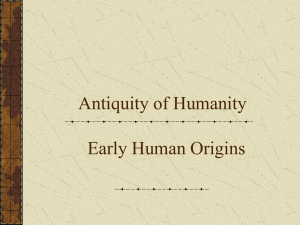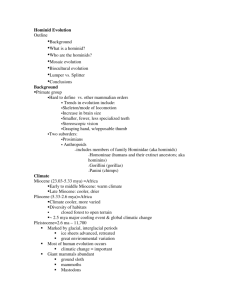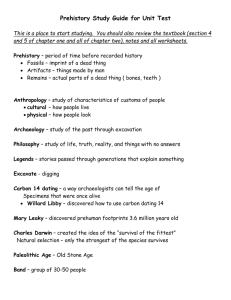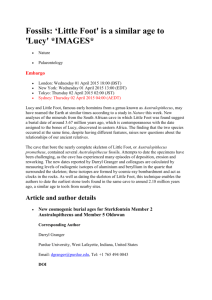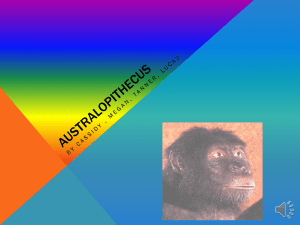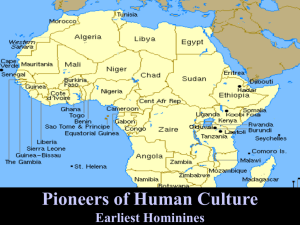4. - GEOCITIES.ws
advertisement
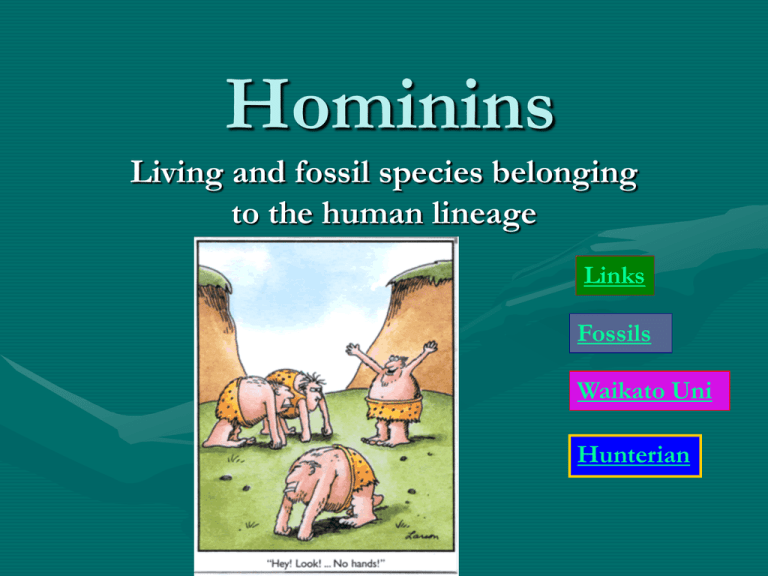
Hominins Living and fossil species belonging to the human lineage Links Fossils Waikato Uni Hunterian Sahelanthropus tchadensis • “Sahel hominid from chad”. • 6 – 7 m.y.a. (about the time our line split off) – brain (350cc) & skull chimp-like but thicker brow ridges and face flatter – Smaller canine teeth than chimp Orrorin tugenensis • • • • • • • “Original Man” (page 217) 6 m.y.a. Arm and thigh bones, lower jaws, and teeth. Chimp size. Upright walking? Smaller canines, thick enamel Lived in dry forest? Ardipithecus kadabba • Kadabba = “basal family ancestor". • 5.54 – 5.77 m.y.a Ardipithecus ramidus • In the Afar language Ardi means "ground". 'Ramid' means 'root‘. Pithecus = ape • 4 – 6 m.y.a. (“Ardi” 4.4 m.y.a.) • About 120 cm tall and 50 kg. • Ape-like upright walker – suggested by toe structure. • Feet well adapted to grasping, (big toe not in line with others) and able to climb trees. The structure of Ardi's feet, pelvis, legs and hands suggest that she was a biped on the ground, but a quadruped in the trees. Did NOT knuckle walk. • Chimp sized brain. • Teeth resemble modern human teeth more closely than they do those of a chimpanzee. • Lived in woodland conditions. Australopithecus anamensis • • • • Austral = southern Turkana word anam, meaning "lake". 3.9 – 4.1 m.y.a. Upright walking Kenyanthropus platyops • • • • • Flat faced man of Kenya 3.2 – 3.5 mya Brain 350cc Toe bone suggests upright. Around same time as A. afarensis. • Controversial - may be A. afarensis or other hominin. Australopithecus afarensis “Lucy” • • • • • Afar is an area in N.E. Africa 2.9 – 3.9 m.y.a. Upright walking Small brain (430 cc average) Sexual dimorphism A. afarensis skull • Ape-like • Large canines and diastema Australopithecus bahrelghazali • Bahr el ghazali = a valley in Chad • 3 – 3.5 mya • Appears similar to A. afarensis, but from central Africa. • This is all there is of it!!! Australopithecus garhi • • • • Garhi = surprise in Afar language 2.5 m.y.a Cranial capacity 450cc Big canine teeth like A. afarensis, but bigger molars • Tool user? Australopithecus africanus • • • • • • (“Southern ape of Africa") First Australopithecine found 2 – 3 m.y.a. Slightly more human-like than A. afarensis Brain 430 – 520 cc Less sexual dimorphism Taung Child • Australopithecus africanus “Mrs. Ples” • A. africanus Gracile or Robust • Australopithecus afarensis and africanus, and the other species above, are known as gracile australopithecines, because of their relatively lighter build, especially in the skull and teeth. • The following Paranthropus species (formerly also called Australopithecus) are called robust australopithecines because of their heavier build. This is probably related to a diet of coarse plant foods. Paranthropus aethiopicus • Greek para "beside", Greek anthropos "human" • Aethiopicus - Ethiopia • Primitive features (e.g. prognathic face) shared with A. afarensis, but more robust. • 2.5 – 2.7 m.y.a. • Brain size 410 cc. The Black skull Paranthropus boisei • • • • • Charles Boise funded Leaky’s expedition. 1.2 – 2.5 m.y.a. Brain 500 – 530 cc Marked Sexual dimorphism Zinj East Africa Paranthropus robustus • • • • • Robust = heavy build 1 – 2.5 m.y.a Brain 450 – 550 cc Moderate Sexual dimorphism South Africa Australopithecus sebida • • • • • About 2 million years ago Approximately 1.3 meters tall. May be transitional between A. africanus and Homo Its cranial capacity is estimated at around 420-450 cm3, Modern hand, whose precision grip suggests it might have been tool-making • If not a transitional species, it may have been a late southern African branch of Australopithecus coexisting with already existing members of the Homo genus. Australopithecus sebida Walking • The combination of traits in Australopithecus sediba shows transition from a form adapted to partial arboreality to one adapted to bipedal walking. • The legs and feet point to a previously unknown way of walking upright. With each step, Australopithecus sediba turned its foot inward with its weight focused on the outer edge of the foot. This odd way of striding may mean that upright walking evolved on more than one path during human evolution.
